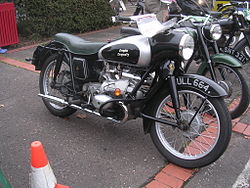- Douglas Dragonfly
-
Douglas Dragonfly 
Manufacturer  Douglas Motorcycle Company, Bristol
Douglas Motorcycle Company, BristolProduction 1955–1957 Predecessor Douglas 500 cc Engine 348 cc (21.2 cu in) horizontally opposed twin cylinder four stroke Power 17 bhp @ 6000 rpm Transmission Four speed Suspension Girling Weight 365 pounds (166 kg) (dry) Fuel capacity 5.5 imperial gallons (25 L) The Douglas Dragonfly was a British motorcycle designed and built by Douglas motorcycles in Bristol. The last motorcycle produced by the company, the 1955 Dragonfly was an all-new motorcycle built to use an improved version of an existing engine. It did not sell well however, and only 1,600 Dragonfly motorcycles were produced before the company was taken over and production ended in 1957.
Contents
History
After World War II Douglas was in financial difficulty and reduced its output to the 350 cc flat twin models. The flat twin had been the Douglas trademark since 1906 and had a long history of Isle of Man TT racing successes.[1]
Development
The Dragonfly was known as the Dart while in development and was based on the Mark V Douglas and an earlier 500 cc (30.5 cu in) prototype. Aiming to overcome the outdated image, designers were commissioned from the Reynolds Tube Company to develop a completely new open duplex frame of welded tubing, including a swinging arm with twin Girling dampers (state of the art for the time) with leading link front suspension. The strengthened and streamlined 348 cc (21.2 cu in) engine had a modern coil ignition AC generator and distributor, with bolt-through cast iron cylinders and heads and duralumin pushrods.[2]
Launch
The launch of the Dragonfly was the last chance of survival for the Douglas company when it featured at the 1954 Earls Court motorcycle show in a big display held in a giant micrometer. Although it aroused a lot of interest, Douglas' finances did not allow them to exploit demand and the Dragonfly did not go into volume production for nine months.[2]
Decline
As well as production delays, the Dragonfly was bigger and heavier than its predecessors but no more powerful. It was also noisy and acceleration was sedate. Douglas decided to concentrate on importing Vespa scooters which were increasing in popularity and only 1,600 Dragonfly motorcycles were ever built.[3] The Westinghouse Brake and Signal Company Ltd bought Douglas out in 1956, and production of Douglas Motorcycles ended in 1957 with the final Dragonflys being sold at discount by London dealer Pride & Clarke.[4]
Restoration
The Douglas Dragonfly has gained a strong following from vintage motorcycle enthusiasts and active owners clubs around the world. The London Douglas M.C.C. has grown to become an International Club for Douglas owners and now has over 1,100 members.[5]
References
- ^ Brown, Roland (2002) (in English). Classic Motorcycles. Joanna Lorenz. ISBN 1 84038 433 6.
- ^ a b Kemp, Andrew; De Cet (2004). Classic British Bikes. Mirco. Bookmart Ltd. ISBN 1-86147-136-X.
- ^ "Douglas Dragonfly". http://www.realclassic.co.uk/doug04022400.html. Retrieved 2008-10-25.
- ^ Roland Brown (November/December 2008). "1955 Douglas Dragonfly". Motorcycle Classics. http://www.motorcycleclassics.com/motorcycle-reviews/1955-douglas-dragonfly.aspx?page=4. Retrieved 2009-08-10.
- ^ "The London Douglas Motorcycle Club". http://www.douglasmcc.co.uk/. Retrieved 2008-10-25.
See also
- List of Douglas motorcycles
External links
Categories:- Douglas motorcycles
Wikimedia Foundation. 2010.
